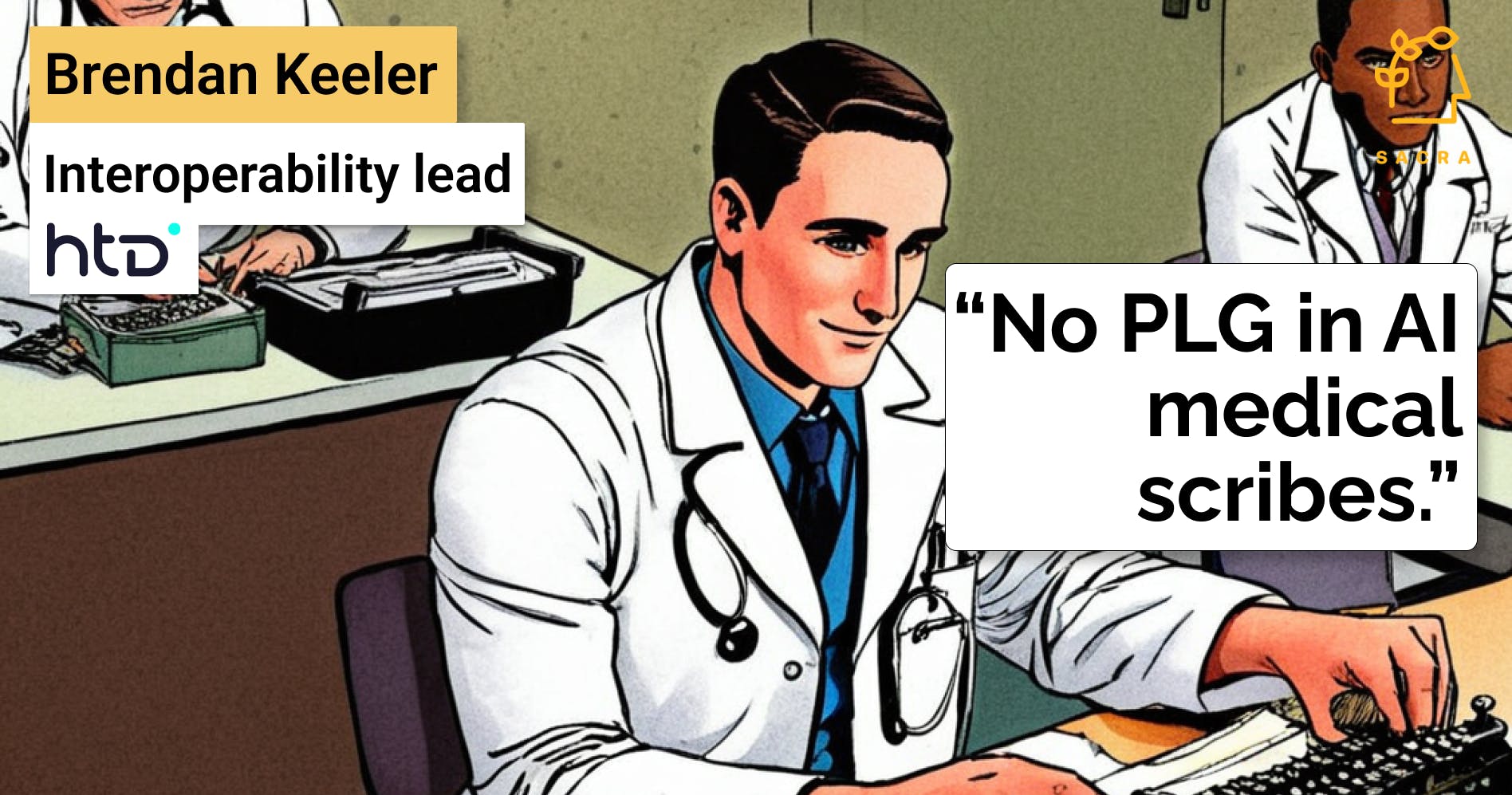Brendan Keeler, interoperability lead at HTD Health, on GTM for AI medical scribes
 Jan-Erik Asplund
Jan-Erik Asplund

Background
AI medical scribes like Ambience (Kleiner Perkins, $100M raised), Abridge (Lightspeed, $212.5M raised), Nuance (acquired by Microsoft for $19.7B), Freed (Sequoia, $11M ARR), Heidi Health (Blackbird, $15M raised), Nabla (Cathay Innovation, $45M raised) and Suki (Venrock, $165M raised) have raised close to $1B and found strong product-market fit. To learn about how AI medical scribes are seizing on that traction, we interviewed Brendan Keeler, interoperability practice lead at HTD Health.
Key points from our conversation via Sacra AI:
- AI medical scribes use speech-to-text models and large language models (LLMs) to turn patient conversations into structured notes and electronic health record (EHR) data, saving doctors 3 hours per day on data entry and replacing $40K/year transcriptionists with $100-200/month SaaS subscriptions. “In the past, we've had manual scribes to write things down or type into a computer, and we've had transcription and transcriptionists with a multitude of solutions. . . Transcription and traditional scribes are rather clumsy, filing back notes. . AI scribes promise to eliminate the computer interface, reverting the doctor's touchpoint back to conversation with the patient.”
- To ensure that all the data around the patient lifecycle—from initial consultation to billing—remains on their platform, EHRs are fighting top down to own the AI scribe experience, from Epic’s (38% market share) tight partnerships with Abridge and Nuance to Oracle’s Cerner (22% market share) building its own. “Abridge had to essentially sell the farm to get their deal with Epic. Epic now owns a ton of their equity and Abridge pays them a big revenue share. This arrangement is very powerful for their business, but the idea that [AI scribes are] a wedge to disrupt the industry is where I think a lot of people go wrong. . . as a partner of Epic, Abridge can't really go to war with them.”
- Bottom up, PLG-oriented AI scribes like Freed ($11M ARR, growing 214% YoY) and Heidi Health (Blackbird, $15M raised) have grown fast selling into small clinics and individual doctors, but land and expand is limited by the small number of seats in these practices and the long tail of EHR integrations to build. “I think healthcare is the most challenging market for product-led growth. . . You can implement PLG for single-doctor practices or sneak it by for smaller groups, but as soon as you need to integrate with an electronic health record (EHR) system and deal with larger health systems, you have to go through the IT team. This necessitates a business associate agreement, which essentially turns it into an enterprise sale.”
Questions
- What exactly is the problem that AI scribes solve in the first place? What did the world look like before for your average doctor, nurse, or other healthcare professionals using them?
- I do want to circle back to this higher-level thing, but maybe getting into the concrete nuts and bolts of it would be good as well. Are you reverting to getting rid of the computer?
- Who's the buyer between doctors, practices, and administration? What does the budgeting look like for that? Is there existing budget for trying out a SaaS AI scribe, or is it something different?
- You described the Kaiser Permanente top enterprise level approach, but is there any flexibility in the mid-market chains of healthcare organizations? Or is it very standardized?
- We looked at Heidi and Freed. These seem like the two that are more purely bottom-up. I'm not sure, but Heidi may be a little further along. I'm curious what you find potentially interesting about this kind of bottom-up approach. Is it a purely bottom-up go-to-market strategy?
- Outside of go-to-market strategies and EHR integration, what are some other key dimensions along which these various AI scribes differentiate themselves?
- Moving on to the EHRs, you briefly mapped out the market where there's Epic at the high end, and then you see a selection of other ones. Maybe we can start there. Our concept was that Epic owns about 30% of the market, and then there's perhaps a semi-oligopoly of other EHRs.
- Is it possible to build an AI scribe with the best experience in terms of transcription accuracy and user experience, and then have it integrate into this entire long tail of EHRs?
- Do you see someone being willing to build an AI scribe for dental EHRs? Not just for one particular dental EHR system, but for all dentists' EHRs?
- One of the things we've looked at with other companies in AI is how it presents a unique opportunity to get into certain kinds of organizations like enterprises. Looking at AI tools, driven by a lot of hype obviously, it's a huge opportunity to get into organizations. Do you see AI scribes that way as well?
- So maybe instead of disrupting Epic, it's more about what functionality they might incorporate or improve upon.
- I think I understand why the ER is trickier than an inpatient or PCP visit, but just to be clear: Is it because people come into the ER and might be screaming, and a transcription doesn't necessarily know how to format that?
- To quickly map my understanding of PLG in a hospital setting: Do doctors have the influence to be intolerant of a transcription app they don't like? For example, just as designers might insist on using Figma, would doctors say, "We want to use whatever AI we've chosen"? Is that sort of a consideration?
- I think to circle back to the agent use case, in the context of that conversation about copilots versus agents, my thinking was that copilots are for physical healthcare, while agents seem more tailored to virtual care. In that context, scribe is likely a feature of an overall agent platform and probably not a standalone product. Would that be fair to say?
Interview
What exactly is the problem that AI scribes solve in the first place? What did the world look like before for your average doctor, nurse, or other healthcare professionals using them?
Okay, so there are two framings of AI scribes. One is that this is the same problem we've always had, and we're resolving it with new technology. In the past, we've had manual scribes to write things down or type into a computer, and we've had transcription and transcriptionists with a multitude of solutions. Now we have AI – that's one viewpoint.
The other viewpoint is that it's entirely new, not functionally equivalent. Transcription and traditional scribes are rather clumsy, filing back notes. The promise of AI scribes is actually quite different. When you look at AI in healthcare, there are two very broad-based approaches. If you boil down everything that's out there, scribes and beyond, it's either "get rid of the computer" or "replace the doctor."
AI scribes promise to eliminate the computer interface, reverting the doctor's touchpoint back to conversation with the patient. All documentation and computer interaction would be handled automatically. That's one vein of the AI push in healthcare.
The other approach questions why we need this font of clinical decision-making that is often wrong when we could have AI perform low triage, then increasingly higher triage, and eventually replace the doctor entirely.
It's interesting to see this happening across all of AI – do we supplement and make the job easier, or do we replace? It's like copilots versus agents. In many ways, you can view scribes as the copilot approach: let's supplement, make it easier, and improve doctors' lives. Then there's a whole vein of clinical decision support AI that acts as an agent, a doctor agent, to provide clinical care. That's more of the agent approach.
I think agents are self-sufficient, whereas my view of copilots is that they're supplementary. With copilots, there's a person in the middle - there's a manual step. The provider is still there doing the visit; the administrative tasks are what the copilot takes care of. Copilots, in this sense, are supplementary. Ben Thompson of Stratechery wrote about this recently. Copilots add on to enhance capabilities, whereas agents, which you see Salesforce talking about, replace. You don't need to hire a person to do the CRM outbound calls because we have an agent that does that for you. There's a whole other vein of AI that says we don't need the doctor; we can replace the doctor. That's a whole other issue. Just like anything with AI, the ones that are agents replacing jobs scare people more than copilots do.
I do want to circle back to this higher-level thing, but maybe getting into the concrete nuts and bolts of it would be good as well. Are you reverting to getting rid of the computer?
The evolution of electronic health records and SaaS for healthcare providers has led to an increasing burden of documentation. What began as simply typing notes has expanded to include discrete fields for conditions, flow sheets, order placement, and reporting requirements for value-based care.
This has transformed a simple conversation about a patient's condition and treatment plan into exponentially increasing levels of documentation. Physicians now need to input extensive data to ensure compliance, facilitate reporting, provide care, and handle billing. This multiplication of tasks has contributed to physician burnout.
The promise of AI is to alleviate this burden. Instead of typing all this information, the idea is to return to a natural conversation. Currently, the highest market fit and easier problem set is in outpatient ambulatory visits, such as scheduled appointments with dermatologists, oncologists, obstetricians, or primary care physicians. The concept involves having a normal conversation during the visit, with ambient listening technology recording the encounter in high fidelity.
This recording is then accurately transcribed, which is crucial. AI processes this transcription to generate comprehensive documentation. It can pull additional information from the patient's history in the EHR, providing context such as existing conditions, recent doctor visits, or upcoming appointments. The AI then completes all necessary documentation tasks: writing the note, placing orders, filling in flow sheets with discrete data like weight and height, entering diagnoses and conditions.
Hypothetically, at its maximum potential, this technology could replace all documentation tasks, allowing healthcare providers to return to a pre-digital era approach of simply having a conversation and solving problems, without the added burden of extensive data entry.
Who's the buyer between doctors, practices, and administration? What does the budgeting look like for that? Is there existing budget for trying out a SaaS AI scribe, or is it something different?
If you market map all these scribes, what you'll see is a lot of large successes. How is this all possible? It's because they're targeting different market segments, just like any market. There's upscale enterprise, and then there's everything all the way down to SMB.
For doctors, you have single-doctor practices that are almost PLG (product-led growth) in the sense that the buyer is also the decision-maker for a tech purchase. The challenge on that end of the market is that they are not running with all the tailwinds; all the headwinds are for small practices. So you see consolidation. They're running really tight margins, and there's heavy pressure to grow out of a single-doctor practice.
I saw this with my family. My grandfather was a single-doctor practice urologist. When my father became a urologist, they became a 3-doctor practice. Now my father is retiring, and they're joining Summit Health as part of the whole health system. So I've seen the full evolution, and that happens a lot due to reasons that are too complex to get into here.
All this is to say that the long tail, the small businesses, they want to buy and adopt AI, but they can only spend $50. They don't know how to use tech, and they face all the challenges of SMB that you see in other industries. It's just that healthcare feels different.
On the enterprise side, with organizations like Kaiser Permanente and big health systems, it's just like any enterprise buyer. There's a bias towards integrated solutions, so they ask, "What is Epic or the EHR going to offer me?" There's risk aversion, and there are compliance barriers for higher compliance and security that you see in healthcare.
There's an enterprise barrier where the decision-maker or buyer is divorced from the user. For example, with Kaiser Permanente in California, a very large health system, a small outpatient medical group chose one of the scribes. However, this decision was overridden, as reported in the news, by Abridge because it was a partnership with Epic and more proven at the top level as the decision-maker's scribe.
The enterprise sale is slower because there's no product-led growth (PLG), especially due to HIPAA regulations. This means you can't just approach individual doctors; you really have to go through the business and sign a business associate agreement. It adds extra weight to the enterprise sale process.
You described the Kaiser Permanente top enterprise level approach, but is there any flexibility in the mid-market chains of healthcare organizations? Or is it very standardized?
There are about 10 large medical practices and numerous medical groups that might use systems like Athenahealth. As you go across that spectrum, you see different Electronic Health Records (EHRs) and different scribes targeting various niches.
This is due to both the ease of sale and the technical profile of the platform they're building alongside. You have to integrate with the EHR more or less; standalone solutions can only prove themselves out for so long. You can initially give away a product like Heidi, but copy-paste functionality only works for a limited time. Eventually, you have to integrate, and your tactics for integration vary quite a bit according to the EHR.
We looked at Heidi and Freed. These seem like the two that are more purely bottom-up. I'm not sure, but Heidi may be a little further along. I'm curious what you find potentially interesting about this kind of bottom-up approach. Is it a purely bottom-up go-to-market strategy?
I think healthcare is the most challenging market for product-led growth (PLG) because of the business associate agreement requirement. There's no way around it. You can implement PLG for single-doctor practices or sneak it by for smaller groups, but as soon as you need to integrate with an electronic health record (EHR) system and deal with larger health systems, you have to go through the IT team. This necessitates a business associate agreement, which essentially turns it into an enterprise sale.
The only PLG strategy that works in healthcare involves applications that don't require personal health information. Doximity is a great example of this; it's a provider tool for phone calls and networking that doesn't need any patient information. If you're selling a product that doesn't require protected health information (PHI), you can pursue PLG successfully. However, there aren't many opportunities like this because most healthcare problems involve patient information. You typically need to know details about the care provided or the financials.
Outside of go-to-market strategies and EHR integration, what are some other key dimensions along which these various AI scribes differentiate themselves?
This is a fascinating topic in healthcare right now because people are debating various aspects. You can argue about the quality of recording and technical aspects, the quality of transcription and AI, or what happens if your recording gets interrupted and whether it can be pieced together. There are numerous small considerations like that.
At the end of the day, how deeply you do all the administrative work and integration is a key differentiator. That's the promise here - that we're getting rid of the administrative work. If you only push a note back in and have me still type in the diagnoses and problems and place the orders, the job is still not done. So integration is crucial, and it's not just a one-and-done thing. It's about how deep the integration goes, because it's not just about being integrated, it's about whether you've completed jobs 2, 3, 4, and 5.
One thing we sort of punted on was that inpatient care is very different from outpatient care. If you're in the ER and someone's leg has been severely injured, or whatever the case may be, it's a very different setting. Can ambient technology be used there? Can it be used in the ICU or when a patient is admitted? We need to consider whether the product-market fit for ambient technology exists in these settings, or how it needs to be shaped.
Abridge just released their nurse product, and I'm very interested to see if their inpatient nursing product works. That scenario is more contained - you've been admitted, they're checking how you're doing, taking your pulse, and so on. It's more of a routine, easily contained problem space. But there are many messier, less structured settings where ambient technology may struggle. Perhaps someone will figure out or crack those challenges in the inpatient world. However, inpatient care is so diverse in terms of specialties - cardiac surgery is very different from radiology, which is very different from nursing doing inpatient rounds.
Moving on to the EHRs, you briefly mapped out the market where there's Epic at the high end, and then you see a selection of other ones. Maybe we can start there. Our concept was that Epic owns about 30% of the market, and then there's perhaps a semi-oligopoly of other EHRs.
For the top 100 or so health systems, Epic, Cerner, and Meditech are the dominant electronic health record (EHR) providers because they offer integrated solutions. I actually wrote about this recently, so I'll send you a link. Epic is dominant in the inpatient space with probably 50 or 60% market share for the big health systems, while Cerner and Meditech fill in the gaps.
In the outpatient space, Athenahealth is pretty dominant, but there are hundreds of other small, specialized EHRs that focus on different niches. You'll see specialty-specific EHRs for areas like dermatology, dental, and behavioral health. For example, Simple Practice is popular for behavioral health.
As you go down-market, Epic does not have a monopoly or even significant market share. They might be viewed very positively, but no single small practice can choose Epic - it's too big and too heavy. Instead, you see a variety of options: Athenahealth for general outpatient, Simple Practice for behavioral health, WebPT for physical therapy, and a number of new-age EHRs like Canvas, Elation, and Medplum for virtual care and tech-enabled care.
It's very fragmented at the small end of the market. For scribes, that means if you can make the economics work and find your product-market fit, you can succeed by hyper-specializing. For instance, you could focus on doing this really well for dentists and specialize for whatever the dental EHR is.
Is it possible to build an AI scribe with the best experience in terms of transcription accuracy and user experience, and then have it integrate into this entire long tail of EHRs?
It is really hard to do integrations in healthcare, even more so than Finch or Merge in HR, because there are such disparate data concepts. In HR, they can have different data concepts, but it's generally limited to employees, benefits, etc. With healthcare, there are thousands of data concepts, which you then multiply by specialty.
You take that complexity and combine it with the fact that healthcare has been trying to do data exchange since the 1970s, versus HR systems which are more recently doing data exchange. Thus, you have less of a greenfield problem and instead have the baggage of four decades of standards and data formats. You see EDI, these old standards like HL7 and X12, XML standards from around 2000, and JSON standards. FHIR was like the healthcare API.
So if you say, "I want to go across all EHRs," you're dealing with 10,000 formats. That's where Redox and similar middlemen can help you, like Merge or Finch, but then you're not going deep enough. Because when you're circling back to scribes, you need to go deep and solve all the problems, and a generalized API fails to do that.
That's why the Ampersand approach was so relevant to this problem space. If I'm a scribe, I need to go hyper-deep, and I've got to do that myself. Or if there's a cool Ampersand for healthcare, they could help me. But if I do the generalized approach, sure, I can go across EHRs and my total addressable market on paper is bigger, but I'm not competitive with the one that focused on dental or the one that focused on Epic.
Do you see someone being willing to build an AI scribe for dental EHRs? Not just for one particular dental EHR system, but for all dentists' EHRs?
Specialization is happening in this space. For example, Abridge has a partnership with Epic. They and Nuance are the only two companies with development partnerships with Epic. Abridge is saying, "We're going to go deep on this," which is a really good strategy because Epic has deep pockets. It gives them a head start on enterprise sales. They don't win all of them, but they will win a lot in that position.
You see different companies focusing on specific EHRs. There's this guy, Fern Cowan, who's a good follow in this space on LinkedIn. His company, DeepCura AI, consists of three really savvy developers who have created an awesome scribe. They've hyper-focused on certain EHRs. They're headcount-light, but they're shipping a lot of product and being super deep for specific EHRs, potentially even revenue positive.
This is potentially a good space for a bootstrapped AI scribe that goes down-market and targets hyper-specific specialties or EHRs. It's a constrained scope, but I don't think it's a winner-take-all market because you need to be specialized. Maybe over time, a company like Abridge wins enough of Epic that they start to go down-market. They might leverage their huge success and bigger bankroll to get competitive, and then through other modes like data modes, be better at less tangible competitive points. They could price others out or their NLP and parsing could become so good that they dominate.
But typically, with other products like patient engagement solutions, which were popular a couple of years ago, whoever dominates the enterprise doesn't really go that far down-market. Their contract sizes are too big, and they can't rejigger that. The smaller companies really struggle to move up-market. So you see similar patterns of different competitors settling into top-of-market, mid-market, and then fragmented across specialties. Dental, for example, is its own beast of solutions.
One of the things we've looked at with other companies in AI is how it presents a unique opportunity to get into certain kinds of organizations like enterprises. Looking at AI tools, driven by a lot of hype obviously, it's a huge opportunity to get into organizations. Do you see AI scribes that way as well?
I don't see healthcare as an area every investor should be betting on. Abridge had to essentially "sell the farm" to get their deal with Epic. Epic now owns a ton of their equity and Abridge pays them a big revenue share.
This arrangement is very powerful for their business, but the idea that it's a wedge to disrupt the industry is where I think a lot of people go wrong. I don't see that potential because Abridge is a development partner of Epic. If they were going to do something highly competitive that would anger Epic, Epic would likely stop working with them and choose a different partner willing to develop collaboratively.
The point is that as a partner of Epic, Abridge can't really go to war with them. So I find it difficult to see Abridge as a true disruptor. I think it's a good business for Abridge because they are ahead of the curve.
Abridge is always 3 to 6 months ahead of competitors like Nabla or DeepScribe in terms of depth of integration with Epic. As we discussed, that is the most important differentiating factor. Other companies like Nabla or DeepScribe need to be fast followers, never lagging on any of those features. The continued reduction of administrative tasks to zero is the promise of AI copilots in healthcare.
So maybe instead of disrupting Epic, it's more about what functionality they might incorporate or improve upon.
I think it's just expansion across all areas. People think AI scribe is done, but the inpatient settings and other care environments are much trickier and actually have a higher potential impact. If you can solve the ER workflow, that's incredibly valuable. You've made a high-stress environment that much easier to manage.
There are also many other AI companies developing copilots for back-office functions. Your core competency as a scribe doesn't really translate, except for your distribution advantage. You have relationships with every hospital, but you still have to essentially rebuild against a whole array of AI products that are creating copilots for back-office agents.
I think I understand why the ER is trickier than an inpatient or PCP visit, but just to be clear: Is it because people come into the ER and might be screaming, and a transcription doesn't necessarily know how to format that?
If you think about the workflow cycle for an ambulatory or outpatient visit, you go into the room, sit down, and they say, "Hey John, how's it going? What's wrong?" That scenario is easier to transcribe than walking into the ER where someone might come in after being hit by a bus. There are different dynamics in a controlled setting versus the ER or surgery.
The format and workflow of outpatient visits are fairly consistent across specialties: schedule a visit, check-in, go into the room, have the visit, maybe take some measurements, walk out, and possibly check out. You get a bill later. Inpatient care has many more entry points. You might have a scheduled surgery or an emergent situation. You go into the hospital, receive care, and transfer between departments. It's a tangled web of workflows and providers in different types of settings that aren't always controlled.
Unlocking different pieces of that inpatient experience is much trickier, in my mind. I don't work directly with AI scribes, so I could be wrong, but you see most scribes focused on ambulatory settings and encounters. I expect that's where AI scribes will go next because it's closer to what they've already built. When developing new products, you look for synergies and strengths you've already established.
Abridge has already shown that they've sold to hospitals, have the Epic relationship, and are now moving into inpatient care, building for nurses who attend to admitted patients. It's a slightly controlled environment where nurses come in, ask how the patient is feeling, take measurements, and do documentation. That subset of the full inpatient experience is controlled and lends itself to ambient technology.
In contrast, during surgery, there might not be as much talking beyond phrases like "Scalpel now, cutting here." You can see how that might require different or more complex work to implement AI scribing.
To quickly map my understanding of PLG in a hospital setting: Do doctors have the influence to be intolerant of a transcription app they don't like? For example, just as designers might insist on using Figma, would doctors say, "We want to use whatever AI we've chosen"? Is that sort of a consideration?
We hope, but it depends. The closest reality is the vertical SaaS that they choose in their enterprise. You don't choose Epic as a doctor; your CFO and CEO do. That's the Kaiser Permanente story - the doctors in a small practice within the overall Kaiser enterprise wanted to use Nabla, but then the top level said, "No, we're using Epic across it all."
Maybe we see this with any healthcare product that has a slight PLG bent. This does in some ways, but you still have forces like business associate agreements that come from HIPAA. These force businesses to make agreements with other businesses in a way that you can't make as a single user, depending on the organization. I hope some organizations allow that because it would be empowering for providers.
The law, HIPAA, has some good aspects but also a lot of weird second-order effects. The chilling effect on PLG is 100% one of them.
If you get a smart lawyer, they will find a way to help your product be PLG (product-led growth). However, you will eventually encounter an enterprise customer that says, "What is this? This is not how we do business." Even though you bundle a business agreement into your terms of service, that's not sufficient for some enterprises. That's part of the challenge.
I think to circle back to the agent use case, in the context of that conversation about copilots versus agents, my thinking was that copilots are for physical healthcare, while agents seem more tailored to virtual care. In that context, scribe is likely a feature of an overall agent platform and probably not a standalone product. Would that be fair to say?
People are saying that the trend of scribes is moving towards feature rather than product. There's a popular notion that commoditization and EHRs are going to build it into their platform. I'm not sure about that. I think there absolutely will be some EHRs, like Elation Health, that will build their own and try to offer it bundled in.
In my mental model of copilots and agents, scribes are ultimately trying to augment capabilities. You're not getting rid of a provider; the provider is still having a conversation. Scribes are copilots alongside the provider to make their life easier.
There's another wave of AI that's a tougher sell when it's replacing headcount, especially provider headcount, and when it's forcing higher cognitive tasks onto providers. For example, if you call in and talk to an AI agent doctor, they might say, "Okay, here's my ibuprofen recommendation." What you've done is increase efficiency for the healthcare organization, but you force the higher acuity cases onto the real provider. While that's good from a top-of-license perspective, it's really stressful for providers.
It's weird to say this, but this probably goes for all of us in the AI era: as we've moved to top-of-license work, there is no break anymore. You never have the break of the patient with a cough; you only have severely high acuity patients all the time. I think people are grappling with what that work means for them in terms of stress.
I see optimism in everything I say. Copilots for top-of-license tasks will make that less stressful. So the world of agents and copilots combined can lead to a better experience and better care for everyone.
Disclaimers
This transcript is for information purposes only and does not constitute advice of any type or trade recommendation and should not form the basis of any investment decision. Sacra accepts no liability for the transcript or for any errors, omissions or inaccuracies in respect of it. The views of the experts expressed in the transcript are those of the experts and they are not endorsed by, nor do they represent the opinion of Sacra. Sacra reserves all copyright, intellectual property rights in the transcript. Any modification, copying, displaying, distributing, transmitting, publishing, licensing, creating derivative works from, or selling any transcript is strictly prohibited.






